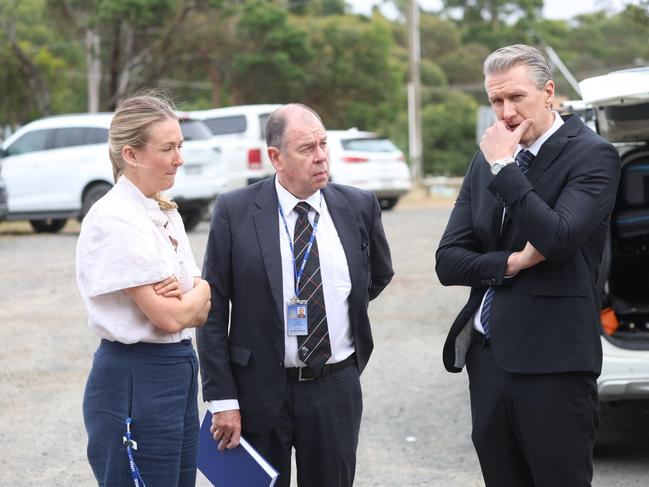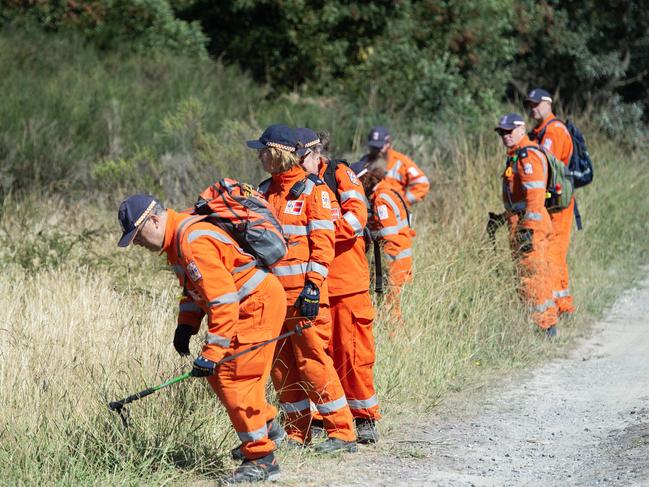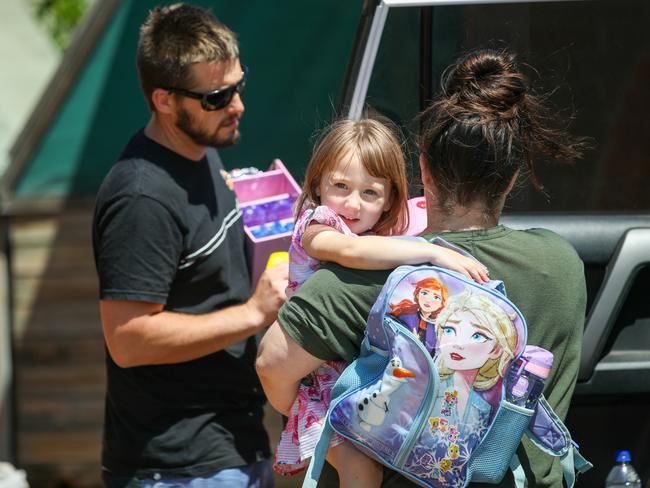Andrew Rule: Samantha Murphy’s loved ones left praying for the best
No one wants to spell out the bitter truth in cases like Samantha Murphy’s disappearance — when people vanish for more than a few days, the odds against their return grow longer with every hour.
Police & Courts
Don't miss out on the headlines from Police & Courts. Followed categories will be added to My News.
Miracles can happen. Samantha Murphy’s loved ones have been praying for one for the last 20 days. But as the third week of their ordeal arrives this Sunday, sinister possibilities surround the mystery of Ballarat East.
The renewed police search this weekend suggests they firmly suspect foul play. But that does not mean it isn’t so.
Police have also kept quiet about whether they believe the missing woman actually did go jogging that Sunday morning, February 4. Their silence doesn’t mean they believe she did. Or, if she did, how far she got.
No one wants to spell out the bitter truth: when people vanish for more than a few days, unless they are voluntary “runaways” with well-laid plans, the odds against their return grow longer with every hour.
The reality of modern life means anyone not under deep cover “off the grid” automatically leaves an electronic trail of banking and shopping transactions, telephone signals and round-the-clock footage from the growing mass of public and private security cameras and car dashcams.
Sophisticated spies and clever criminals might set up false identities and safe houses and secret stashes of cash so they can slip under the radar indefinitely. For the rest of us, it doesn’t happen like that.

In 2024, for investigators trying to trace a regular wife and mother like Samantha Murphy, what’s as ominous as a drop of blood is the absolute absence of a bank transaction.
Even a decade ago, there were fewer cameras, especially dashcams and home security units. Most of us were more inclined to use cash then than we are now, after the mass switch to cashless transactions during the pandemic.
In the Murphy case, the awful silence leaves nothing but the desperate hopes and blind faith of the brokenhearted, those who love her.
Marriage partners leave each other every day, some more suddenly and secretly than others. But those who know Samantha Murphy best describe a devoted mother who wouldn’t willingly leave her kids for three days, let alone three weeks. Forget the runaway wife angle.
As the days pass, the chances of finding her alive are shrinking almost to nothing. Meanwhile, the absence of a body or signs of violence inevitably supports a glimmer of hope.
That is why dedicated detectives in missing person cases see their job is often to extinguish all hope, as they did so well in the Wonnangatta campers investigation in eventually uncovering the remains of Russell Hill and Carol Clay. Without the police’s doggedness, those families would be tormented by some irrational hope forever.
The scenario that the missing might be alive somewhere after being abducted by a deranged kidnapper is barely feasible, but the appalling silence can drive grief-stricken people to a sort of insanity.
I once spent time with a middle-aged man whose sister and her husband had disappeared 30 years earlier. He said the strangest thing: that when his sister didn’t “come home” for their mother’s funeral (after a quarter of a century) he’d realised he probably wouldn’t see her again.

He never could grasp the brutally simple explanation that the couple had drowned in extremely cold water discharged from Eildon Weir, their bodies buried in silt. Cold logic and extreme grief do not mix.
This otherwise ordinary man was tortured by grotesque fantasies that shadowy international kidnappers had snatched his sister, presumably killing her husband, and “sold” her into slavery in the middle east. A plot from a 1920s pulp crime novel.
The reality, statistically, is overwhelmingly that those who disappear completely for years are dead. And yet, of course, there is the faintest of chances that one or two are alive.
It has happened in rare and bizarre cases in Europe and in America, where high-functioning psychopaths have hidden young women or children in private bunkers. When and if such victims were rescued years later, it’s as if they’d come back from the dead.
In that sense, miracles can happen and prayers can be answered — but not often. That’s why the Cleo Smith case made news across the world in 2021.
Cleo was the four-year old who went missing from a family’s tent in a remote West Australian campsite in October 2021. She was found alive and well 18 days later, when police raided the home of a strange young man, Terence Darrell Kelly, in the town of Carnarvon, 80km from the campsite.
There was a massive sense of relief that Cleo wasn’t another Maddie McCann, the tiny English girl taken from a Portuguese resort room in 2007 and never seen again, a case that gripped imagination worldwide.

At first, of course, the police had to eliminate the man closest to Chloe’s family, her stepfather. But once that unfortunate man was cleared of suspicion, the family and investigators faced the awful truth that Chloe had been abducted by a stranger who could be almost anyone.
If it hadn’t been for an alert shopkeeper in Carnarvon noticing that Terence Kelly, an oddball single man, had started buying disposable nappies, it’s hard to know when and how Chloe might have been found.
If Chloe’s rescue seemed like a miracle, here’s a bigger one: the reappearance after nearly five years of Queensland schoolgirl Natasha Anne Ryan, 14, who vanished after her mother dropped her at school in Rockhampton on August 31, 1998.
Police first assumed, wrongly, that Natasha’s 15-year-old friend, Maioha Tokotaua, had killed her. Then they switched blame to a more likely candidate, serial sex killer Leonard Fraser, believed responsible for several abduction-murders in northern Queensland.
It seemed so overwhelmingly likely that Natasha was dead that her family held a memorial service for her in Bundaberg to mark her 17th birthday in May 2001.
It wasn’t until Fraser, already a convicted child-killer serving time, was standing trial in 2003 for the murder of Natasha Ryan (and three other young women) that the astounding truth emerged.
On the morning of April 11, 2003, the trial prosecutor dropped a bombshell: police had found Natasha the previous night after a tip-off that she was living secretly at a suburban Rockhampton house with her older boyfriend, Scott Black, by then in his mid-20s.

Ryan, by this time almost 19, was found hiding in a wardrobe in what was the second house the lovers had shared over almost five years. The connection with Scott Black was known to police and the Ryan family, as Natasha had been found with the young milkman after running away with him for two days just weeks before she disappeared again, this time apparently permanently.
It was not the Queensland police’s finest hour. A random search of Black’s home any time from September 1998 until 2003 would have found the schoolgirl who’d eloped with the young milkman.
There was also the embarrassing fact that police had elicited a murder confession from Fraser, complete with a map of where he’d allegedly dumped Natasha’s body. All clearly bogus.
This wasn’t a problem for the judge, apparently, who reasoned there were plenty of other murders to lay at Fraser’s door. There was also the grim fact that Fraser had kept unidentified ponytails as trophies, implying other murders he wasn’t charged with.
Fraser’s defence counsel did not claim a mistrial and the court resumed. And so Natasha Ryan was called to what had been the trial of her own supposed killer.
She told the court she had never met Fraser nor the witness who’d sworn seeing her near Fraser before she went missing.
As women’s magazine readers and television current affairs show fans might recall, Natasha went on to marry her milkman in 2008 and to have three children.
One reason for the wedding to be delayed so long was that in 2005, the prospective groom, Scott Angus Black, paid the price for telling porkies to police by serving one year of a possible three-year jail sentence.
To be fair, suggestions that Black had brainwashed or manipulated his young lover never stood up. She cried when he was sentenced, waited for him to come home from jail, and they appear to have lived as happily ever after as most and better than many.
Natasha Ryan and Scott Black were fined modest amounts for the lies they had told and the unspeakable grief they’d caused to Natasha’s parents. They used payments from magazines and television networks to set themselves up while Natasha studied nursing.
Their happy ending, though, was the exception that proves the rule about the vanished. It is an outlier in a sea of bad endings.
Sometimes, after many years, human remains turn up and end the agony of those left behind. Such a grim discovery is as much a reprieve as a blow.
The worst endings of all are when there’s no actual proof that the disappeared are dead. Because the remains are not found, the “not knowing” haunts those who love them.
So many people have vanished, apparently without trace.
In Victoria, there’s the case of Bung Siriboon, the 13-year-old who walked out the door of her family’s Boronia home in June 2011 to go to school and was never seen again.
There is the case of Suzanne Lawrence, who vanished while walking home from a party in Healesville in February 1987.
There is the case of Kath Bergamin, beautiful but terrified wife and mother, abducted from her Wangaratta unit in August, 2002.
Police are confident they know who took Kath, but not where her body is. The same applies to Kerry Whelan, who went to meet someone at a Parramatta Hotel in 1997 and was never seen again. A man was convicted of her murder but her family will never get to bury her.
There’s always the chance of a miracle but it’s not the way to bet.




